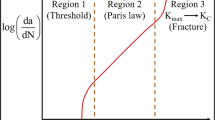Abstract
The addition of liquid-filled urea-formaldehyde (UF) microcapsules to an epoxy matrix leads to significant reduction in fatigue crack growth rate and corresponding increase in fatigue life. Mode-I fatigue crack propagation is measured using a tapered double-cantilever beam (TDCB) specimen for a range of microcapsule concentrations and sizes: 0, 5, 10, and 20% by weight and 50, 180, and 460 μm diameter. Cyclic crack growth in both the neat epoxy and epoxy filled with microcapsules obeys the Paris power law. Above a transition value of the applied stress intensity factor ΔK T, which corresponds to loading conditions where the size of the plastic zone approaches the size of the embedded microcapsules, the Paris law exponent decreases with increasing content of microcapsules, ranging from 9.7 for neat epoxy to approximately 4.5 for concentrations above 10 wt% microcapsules. Improved resistance to fatigue crack propagation, indicated by both the decreased crack growth rates and increased cyclic stress intensity for the onset of unstable fatigue-crack growth, is attributed to toughening mechanisms induced by the embedded microcapsules as well as crack shielding due to the release of fluid as the capsules are ruptured. In addition to increasing the inherent fatigue life of epoxy, embedded microcapsules filled with an appropriate healing agent provide a potential mechanism for self-healing of fatigue damage.








Similar content being viewed by others

References
Cardoso RJ, Shukla A, Bose A (2002) J Mater Sci 37:603
Bagheri R, Pearson RA (1996) J Mater Sci 31:4529
Skibo MD, Hertzberg RW, Manson JA, Kim SL (1977) J Mater Sci 12:531
Paris PC, Gomez MP, Anderson WE (1961) The Trend in Engineering at the University of Washington 13:9
Karger-Kocsis J, Friedrich K (1993) Compos Sci Technol 48:263
Nagasawa M, Kinuhata H, Koizuka H, Miyamoto K, Tanaka T, Kishimoto H, Koike T (1995) J Mater Sci 30:1266
McMurray MK, Amagi S (1999) J Mater Sci 34:5927
Becu L, Maazouz A, Sautereau H, Gerard JF (1997) J Appl Polym Sci 65:2419
Rey L, Poisson N, Maazouz A, Sautereau H (1999) J Mater Sci 34:1775
Hayes BS, Seferis JC (2001) Polym Compos 22:451
Azimi HR, Pearson RA, Hertzberg RW (1996) Polym Eng Sci 36:2352
Azimi HR, Pearson RA, Hertzberg RW (1995) J Appl Polym Sci 58:449
Sautereau H, Maazouz A, Gerard JF, Trotignon JP (1995) J Mater Sci 30:1715
Azimi HR, Pearson RA, Hertzberg RW (1996) J Mater Sci 31:3777
Brown EN, White SR, Sottos NR (2004) J Mater Sci 39:1703
White SR, Sottos NR, Geubelle PH, Moore JS, Kessler MR, Sriram SR, Brown EN, Viswanathan S (2001) Nature 409:794
Brown EN, Sottos NR, White SR (2002) Exp Mech 42:372
Kessler MR, Sottos NR, White SR (2003) Composites Part A 34:743
Brown EN, Kessler MR, Sottos NR, White SR (2003) J Microencapsul 20:719
Brown EN (2003) In: Fracture and Fatigue of a self-healing polymer composite material, PhD dissertation, University of Illinois at Urbana-Champaign
Rzeszutko AA, Brown EN, Sottos NR (2004) 2003 Proceedings of 5th Undergraduate Research Conf. in Mechanics, University of Illinois at Urbana-Champaign, TAM Report No. 1041, 27
Mostovoy S, Crosley PB, Ripling EJ (1967) J Mater 2:661
Wang WZ, Li CT, Ye FX (2004) Vacuum 73:649
Blackman BRK, Hadavinia H, Kinloch AJ, Paraschi M, Williams JG (2003) Engng Fract Mech 70:233
Macon DJ, Anderson GL (2002) J Appl Polym Sci 86:1821
Beres W, Koul AK, Thambraj R (1997) J Test Eval 25:2419
Cammino R, Gosz M, Mostovoy S (2000) In: Proceedings of ASME International Congress and Exposition 415:17
Kessler MR (2002) In: Characterization and performance of a self-healing composite material, PhD dissertation, University of Illinois at Urbana-Champaign
Saxena A, Hudak SJ Jr (1978) Int J Fract 14:453
Karger-Kocsis J, Friedrich K (1992) Colloid Polym Sci 270:549
Chudnovsky A, Kim A, Bosnyak CP (1992) Int J Fract 55:209
Irwin GR (1960) Proceedings of 7th Sagamore Ornance Mater. Res. Conf. 4:63
Xiao K, Ye L, Kwok YS (1998) J Mater Sci 33:2831
Araki W, Adachi T, Gamou M, Yamaji A (2002) Proc I Mech E Part L 216:79
Endo K, Okada T, Komai K, Kiyota M (1972) Bull Japan Soc Mech Eng 15:1316
Galvin G, Naylor H (1964) Proc Inst Mech Eng J 179:56
Plumbridge WJ, Ross PJ, Parry JSC (1985) Mater Sci Eng 68:219
Polk C, Murphy W, Rowe C (1975) ASLE Transactions 18:290
Acknowledgments
The authors gratefully acknowledge support from the AFOSR Aerospace and Materials Science Directorate Mechanics and Materials Program (Award No. F49620-00-1-0094), the National Science Foundation (NSF CMS0218863), and Motorola Labs, Motorola Advanced Technology Center, Schaumburg Ill. Any opinions, findings, and conclusions or recommendations expressed in this publication are those of the authors and do not necessarily reflect the views of the AFOSR or Motorola Labs. The authors would also like to thank Profs. J.S. Moore and P.H. Geubelle of the Autonomic Materials Laboratory of the Beckman Institute of Advanced Science and Technology and Dr. A. Skipor of Motorola Labs for technical support and helpful discussions. Electron microscopy was performed in the Imaging Technology Group, Beckman Institute, of the University of Illinois at Urbana-Champaign, with the assistance of S. Robinson. LAUR-04-2668.
Author information
Authors and Affiliations
Corresponding author
Rights and permissions
About this article
Cite this article
Brown, E.N., White, S.R. & Sottos, N.R. Fatigue crack propagation in microcapsule-toughened epoxy. J Mater Sci 41, 6266–6273 (2006). https://doi.org/10.1007/s10853-006-0512-y
Received:
Accepted:
Published:
Issue Date:
DOI: https://doi.org/10.1007/s10853-006-0512-y



